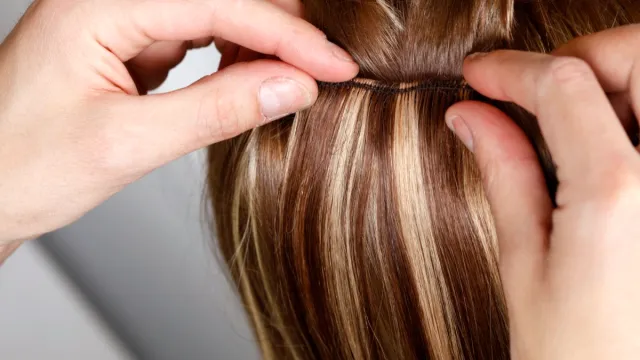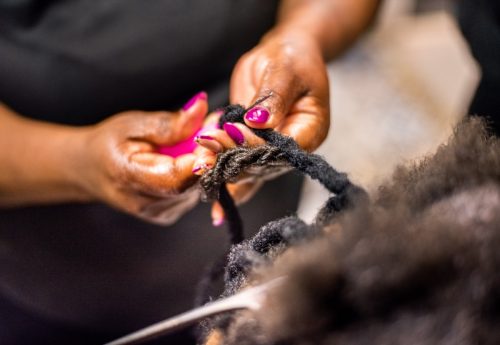8 Tips for Getting Hair Extensions Over 60

Our hair may be one of our defining features, but that doesn’t mean we don’t want to switch it up from time to time—whether that’s a fun new color or a stylish cut. If you aren’t looking for a trim, however, you might be considering hair extensions, which can offer a real transformation, and might be even more useful for anyone over 60.
“Hair generally becomes more brittle, frizzy, and a bit lackluster as we get older,” Sophie Thomas, stylist and hair extension specialist at Josh Wood Colour, tells Best Life. “With the hair naturally losing its pigment over time, it can also become more stubborn to accepting color, which results in a lot more color maintenance as white/grey hairs creep in faster.”
According to Thomas, hair extensions can combat these issues, while adding length and versatility.
“They are particularly beneficial to those worried about thinning hair and changes in texture as they help add fullness,” she shares. “Whether you’re short or long, coloring or staying natural, there is an extension that can help.”
Of course, even with all of the benefits, there are still some things you need to know when you’re getting hair extensions later in life. Read on for eight tips to consider before you make your appointment, and after you have your new ‘do.
RELATED: 10 Best Short Haircuts for Women Over 60, Stylists Say.
1
Seek out a specialist.

Across the board, hairstylists recommend talking to a hair extension specialist before you make any big decisions, especially since your hair may have changed in recent years.
Krysta Biancone, co-founder of Amari Salon & Spa and a hairstylist at Hair by Krysta, recommends a professional consultation to ensure you find “the best match for your hair type and lifestyle.”
In addition, Yvey Valcin, master stylist and founder of YVEY Salon, points out that a specialist can help you with finding a match for your hair’s texture.
2
Check the hair quality.

Another important thing to consider is the quality of the hair extensions themselves. In general, human hair is your best option.
“I believe it’s very important to invest in high-quality, human hair extensions that blend with your natural hair,” Dawna Jarvis, media strategist, beauty industry expert, and former salon owner, tells Best Life.
Jarvis notes that these extensions can give you the “volume, length, and youthful look” you may be seeking—but you also have to maintain “realistic expectations.”
“Your stylist can help determine what’s achievable based on your hair’s condition,” she says.
RELATED: 5 Tips for Having Bangs Over 60, According to Stylists.
3
Do some research on different application methods.

There’s no one-size-fits-all approach to hair extensions. In fact, in addition to different hair varieties, there are also different kinds of hair extensions. Some of the more common methods include clip-in extensions, keratin tips (kera tips), tape-in extensions, and sew-ins—all of which have their pros and cons.
“Do some comparison shopping with a few different hair extension specialists so you have a better understanding before you decide which type of extensions you want to get,” Valcin says.
4
Go for clip-ins or tape-ins to avoid damage.

If you want to minimize potential damage to your hair, Biancone recommends tape-ins or clip-ins. Valcin also cites clip-ins as a “great option” if you can’t decide or are uncertain about what kind of extensions you want.
RELATED: 10 Tips for Switching to Shorter Hair After 50, According to Stylists.
5
Mini-customized bonds are a good option for thinning hair.

Thomas points to mini-customized bonds for older women who want a more “discrete extension” that gives hair a “little extra boost.” These can be installed as kera-link extensions—meaning they are attached to your hair using keratin and a heat gun—or via the tape-in method.
Thomas explains, “The ultra-fine bonds are great for even the finest of hair lines, making them the ultimate go-to if you are looking to boost thinning hair and hairlines.”
Jarvis is a proponent of kera-tips as well, flagging these individual extensions as an option for those who want a more tailored look.
“They allow for a more customized approach to volume and fullness, perfect for those who prefer a more subtle enhancement. Not necessarily for length,” she says.
6
Consider sew-ins if you want more of a “youthful touch.”

According to Jarvis, sew-in extensions are her preferred option for clients who want “length, volume, and a youthful touch.”
She adds, “They are easy to install and maintain.”
7
Understand the maintenance involved.

According to Biancone, older hair often requires “gentle handling”—meaning you should be aware of and ready to take on the maintenance hair extensions require.
“Take time to learn how to take care of your extensions at home,” Valcin advises. “Having the proper products to maximize your extension’s full potential is vital to the overall look and longevity.”
In terms of tools, Thomas recommends keeping a soft bristle brush on hand to keep extensions “looking perfect,” and investing in a silk pillowcase and turban. Heat protection and moisture spray are also crucial “to help maintain condition and keep frizz at bay,” she says.
Maintenance is something you should be upfront with your extension specialist about, too.
“[The rule] for maintenance is pretty much the more hair you have, the more you have to look after,” Thomas notes. “Be open-minded and explore all the options, [but] only have what you feel comfortable managing.”
RELATED: 7 Secrets for Growing Out Gray Hair, According to Stylists.
8
Embrace your new look.

Hairstylists point out that extensions are a great way to boost your confidence, giving you more freedom with your hair as you get older.
“One of the best things about getting hair extensions when you are 60+ is that it brings back wonderful memories,” Valcin says. “Most of my clients of this age love beautiful voluminous hair, and adding extensions can help you achieve this look. Also, having a full head of hair gives a youthful look and feeling. ”
If you’re feeling yourself, stylists encourage you to embrace that.
“Confidence is everything, no matter how we style our hair it should make us feel more confident,” Valcin says. “So for women 60 and over looking to add length or volume back into their hair, extensions can make you feel really good about your hair and provide you with more versatility.”